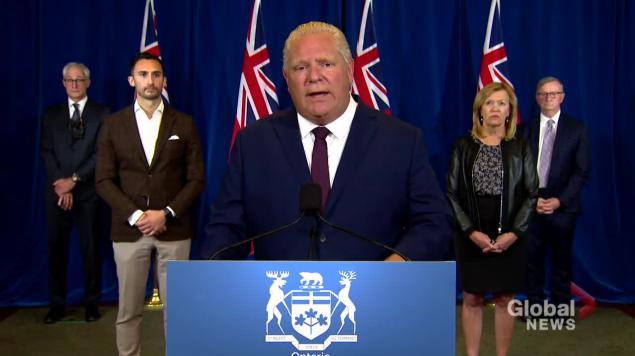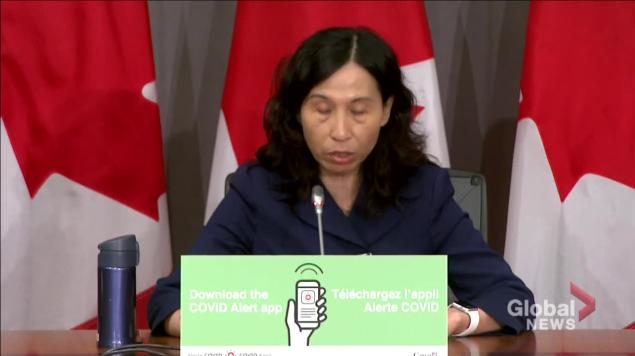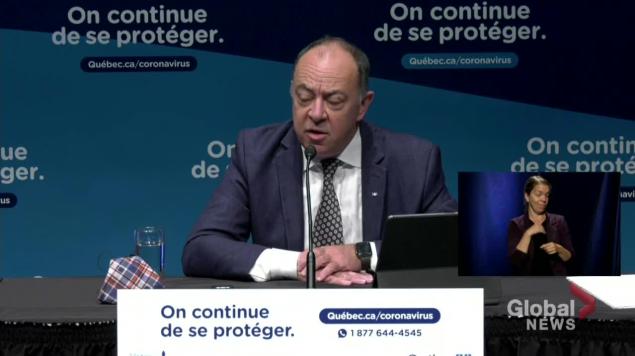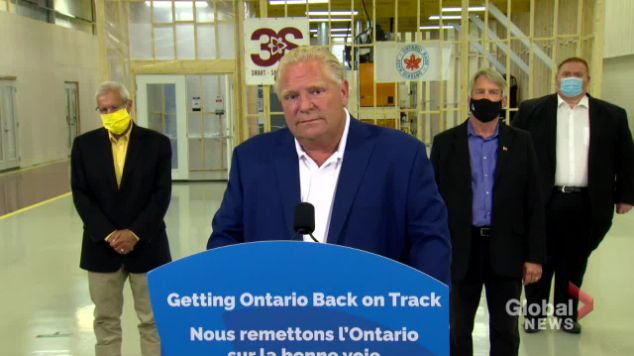COVID-19 PANDEMIC-THE PRE-2ND WAVE: CANADA, ONTARIO- ‘The second wave is going to be more complicated
.
“The 2019 Plague” Day 291


Yahoo News Canada is committed to providing our readers with the most accurate and recent information on all things coronavirus. We know things change quickly, including some possible information in this story. For the latest on COVID-19, we encourage our readers to consult online resources like Canada’s public health website, World Health Organization, as well as our own Yahoo Canada homepage.
As cases of COVID-19 continue to spread around the world, Canadians seem to be increasingly concerned about their health and safety.
Currently, there are more than 6,771 active cases of COVID-19 in Canada (with more than 134,900 diagnoses so far) and 9,100 deaths. Nearly 90 per cent of the country’s reported COVID-19 cases have recovered.
Check back for the latest updates on the coronavirus outbreak in Canada.
For a full archive of the first month of the pandemic, please check our archive of events.
.

September 14
‘The second wave is going to be more complicated’
Ontario’s Deputy Premier and Minister of Health Christine Elliott said the second wave of the COVID-19 pandemic “is coming” and stressed how important it is for everyone in the province to follow all the public health rules and hygiene practices.
“I think it’s fair to say that the second wave is going to be more complicated and more difficult to deal with than the first wave because we also have flu season approaching, in addition to COVID-19,” Elliott said.
“We also have a reduced capacity in our hospital because we have a number of people who were in long-term care homes but because they’ve had to half their capacity for infection prevention and control, they’re back in hospital, and we’re also working on the thousands of surgeries and other medical procedures that were postponed due to the first wave.”
The deputy premier and health minister said people should not go to large gatherings or be in large groups where people are not following hygiene measures “because that’s what’s causing COVID-19 to spread.” She added that Ontario’s fall preparedness plan will be coming “in short ordering.”
Elliott and Ontario Premier Doug Ford would not specify the exact mark the province will have to hit for restriction to be put in place, with over 300 cases reported in the province on Monday, but they said there would be a number of considerations, including the overall trend in case counts and community transmission.
“We will take every step necessary, including further shutdowns,” Ford said. “In the second wave of COVID-19, it’s a scenario that we have been preparing for all summer long.”
Ford said any lockdown measures put in place would have to be executed on a regional basis, with most of the recent COVID-19 cases in Toronto, Peel and Ottawa, linked to social gatherings.
“I’m begging you, please, just cut out the social gatherings, it’s just not worth it,” the premier said. “It’s coming back to bite us.”
.

September 11
‘Now is the time to not be complacent’
Dr. Theresa Tam, Canada’s chief public health officer, defended the decision by the Canadian government to advise against non-essential travel in March, saying that the Level 3 alert was significant, including countries that hadn’t announced any cases yet, even though initial discussions of the virus began earlier in the year.
As the number of COVID-19 cases continue to increase across much of Canada, Dr. Tam said increasing restrictions will be dependant on the local epidemiology.
“The idea is to not let things get to a point where the activity is not manageable,” she said. “I do think we need to monitor not just the numbers everyday but the speed of acceleration, the reproduction number et cetera.”
Dr. Tam added that critical factors will be each region’s ability to detect and track cases, and whether the local public health capacity has been exceeded.
“I am concerned and so are other medical officers of health,” she said. “Now is the time to not be complacent…We do not want this to escalate further.”
Deputy chief public health officer, Dr. Howard Njoo, also spoke about Quebec’s recent karaoke ban in the province, confirming that singing and shouting are known higher-risk activities.
“I don’t think at this point you could consider that a safe activity,” Dr. Njoo said.

Trudeau confirms initial COVID-19 meeting in January

Coronavirus: Trudeau insists experts informed government decisions ‘every step of the way’ in light of Woodward tapes
When asked on Friday about tapes of an interview conducted by veteran journalist Bob Woodward, where U.S. President Donald Trump revealed he knew COVID-19 was a dangerous threat back in February, Canadian Prime Minister Justin Trudeau insisted experts informed the government’s decision-making process “every step of the way.”
At a joint press conference with Ontario Premier Doug Ford, Prime Minister Justin Trudeau said that as of Jan. 2, Dr. Theresa Tam, Canada’s chief public health officer, convened a meeting with her counterparts across the country about the concerns around the virus.
He added that throughout the month meetings occurred and discussions about preparation were being had.
This comes after reports that U.S. President Donald Trump played down early warning signs of COVID-19 back in February.

Alberta changes guidance on singing, concerts
Dr. Deena Hinshaw, Alberta’s chief medical officer of health, announced changes to the guidance around singing and music performances in the province.
Limited band practice, singing and wind instrument concerts can occur provided distancing, cleaning and other precautions are taken. Choirs can also resume in limited numbers with masking.
Dr. Hinshaw stressed that audience singing and group singing in faith settings are still discouraged, and dance floors are still not permitted because it is difficult to safely mitigate exposures in these settings.
Alberta’s chief medical officer of health also stressed that COVID-19 can impact people differently. For example, some may get a fever as the body tries to fight off the virus while in others, the virus causes inflammation, which can lead to them feeling tired and achy. It can also lead to symptoms like pneumonia or trouble breathing.
“Once the virus is inside your body it can latch on to a cell inside your lungs,” Dr. Hinshaw said. “If enough virus latches on to cells and gets inside them, they take over those cells and make copies of themselves.”
“In most people, it will take about five to eight days before enough virus copies are made for symptoms to show.”
Dr. Hinshaw advised the public to stay home if they are at all sick and get tested for COVID-19, but even if the test comes back negative they should stay home until they are feeling better, because the result could have been a false negative.

‘We’re not in a second wave but the trend is not good’
Quebec Premier Francois Legault warned people in the province that a second wave could be on the horizon if public health rules are not followed, as the daily case count soared past 200 on Friday.
“We’re not in a second wave but the trend is not good,” Legault said at a press conference. “And if the trend continues we may come to a second wave.”
The premier also spoke about COVID-19 spreading at private parties, which he admits is difficult to track but something he has also spoken to premier Doug Ford about, with Ontario seeing a similar trend.
“The best way is to try to convince the population to respect the directives,” he said. “Maybe we can eventually do something in houses but at this point, we’re not looking for that.”
“I’m asking the population, please look at the number of cases…it’s serious.”

September 9
Alberta to launch new map of COVID-19 cases in schools
At a press conference on Wednesday, Dr. Deena Hinshaw, Alberta’s chief medical officer of health, said the province will be creating an online map so parents and guardians can see if there may be COVID-19 risks in schools in their community.
Schools will only be added to this map if there are two or more cases in a school setting within a 14-day period, acquired or transmitted in the school. Dr. Hinshaw said all 16 COVID-19 cases linked to 16 schools have not met that threshold at this point.
An example of a situation that would not be included in the map is if there is a family with two children at the same school. One child became him but was kept at home, not able to transmit the virus in the school, but the other became infected with COVID-19 while at home with their sibling.
Dr. Hinshaw also provided clarity on face coverings, stressing that medical face masks protect both the person wearing it and the person around them, which is different from non-medical face masks, like cloth masks.
“When you use non-medical face masks…it doesn’t have the same degree of protection [to] the person wearing it,” she said. “Although there is some emerging evidence that would indicate that wearing those kinds of face masks…may reduce the amount of infectious particles and potentially reduce the chances of having a severe illness.”

B.C. invest $1.6 billion in fall, winter COVID-19 planning
The B.C. government announced it is investing $1.6 billion in a fall/winter preparedness plan to strengthen the healthcare system to manage COVID-19 in the province.
“The actions we are taking today are a big step to help protect everyone in our province as we head into the fall, and in doing that, will also help lessen the impact the pandemic has had on our economy,” B.C. Premier John Horgan said in a statement. “We know people have stepped up to stop the spread, and right now we need good people to step forward to help deliver these life-saving initiatives.”
The plan includes hiring an estimated 7,000 healthcare workers in long-term care homes and assisted living facilities. Individuals will start in a healthcare support worker position and will receive training to become a healthcare assistant. The starting salary will be $20 per hour and particular consideration will be given to people who lost their job as a result of the COVID-19 pandemic.
The B.C. government will also have 45,000 Fluzone-High Dose immunizations available to residents of long-term care and assisted living facilities, with two million total flu vaccines available this year.
The province also plans to increase its testing capacity from approximately 10,000 to 20,000.
The province is also dedicating $42.3 million to develop a Hospital at Home program, where patients can get 24/7 care at home instead of being admitted to hospital. It will launch through the Victoria General Hospital initially.
At a press conference on Wednesday, health minister Adrian Mix presented four scenarios the provincial government is preparing for. The low COVID-19 scenario has few number of new daily COVID-19 cases and beds required in hospitals, approximately 25 in ICU and 57 in acute occupancy. The moderate scenario increases to 55 in ICU and 98 in acute care, the high scenario would see 108 in ICU and 201 in acute care. The top level, “High++” would see 214 in ICU and 400 in acute occupancy.
Dr. Bonnie Henry, B.C.’s provincial health officer, urged everyone in the population to get the influenza vaccine this year.
She added that although cases seem to be rising, she believes Halloween can be celebrated this fall “but it will look different.” Some recommendations include being in small groups outside, celebrating with a small neighbourhood at the end of a driveway, or sharing prepackaged candies so children do not need to sort through a shared pile.

WE Charity ceases operations in Canada
The WE Charity announced Wednesday that the organization is closing its Canadian operations due to impacts from the COVID-19 pandemic and the aftermath of the Canada Student Service Grant sandal.
At this point, the U.K. and U.S. operations have not been impacted, neither is the ME to WE affiliate.
.

Ontario, Quebec premiers call on the federal government for more recurrent financing for health care

Ontario pushes federal government for more healthcare funding ahead of throne speech
Ontario Premier Doug Ford called on the federal government on Wednesday to provide more funding for the Canada Health Transfer program ahead of the throne speech during a joint press conference with Premier Legault, adding that Ontario and Quebec have been on the frontlines of fighting the pandemic in Canada.
Ontario Premier Doug Ford and Quebec Premier François Legault are calling on the federal government to provide more long-term health care funding by increasing the Canada Health Transfer (CHT).
This comes after both provinces caution the public about a possible second wave of COVID-19. Ford said the two provinces have been “on the frontlines” of the pandemic and the systems need to be strengthened for the fall and beyond.
Legault added that the federal government needs to “do its part” with recurrent financing, without conditions. He added that discussions need to occur with other provincial and territorial leaders, but a more specific figure they are looking for will be tabled “very shortly.”
The premiers also spoke about B.C.’s recent move to close nightclubs and stand-alone banquet halls, while also restricting liquor sales at bars, pubs and restaurants.
Ford said if any local public health units have concerns about these venues, or even the overall gathering limits in the province, they have the ability to add additional restrictions.
Legault indicated most of the recent cases in the province are not coming from bars but are stemming from private gatherings.
.

Trudeau asks Canadians to ‘be vigilant’ as the fall season approaches
At a press conference on Wednesday to announce the new $221 million program for Black entrepreneurs in Canada, Prime Minister Justin Trudeau called on Canadians to continue to follow the public health measures in place across the country.
“We are not out of the woods,” Trudeau said. “Canadians need to continue to be vigilant. Canadians need to continue to be careful.”
“The last thing that anyone wants is to have to once again shut down our economies and suspend our lives to try and counter a massive second wave.”
He called on the public to make the right choices to keep the country safe, including trying to not overwhelm Canada’s healthcare system.

September 8
B.C. imposes new restrictions in bars, nightclubs, banquet halls, restaurants and pubs
Dr. Bonnie Henry, B.C.’s provincial health officer, announced a new order to strengthen restrictions at bars, nightclubs, banquet halls, restaurants and pubs.
Effective Tuesday, all nightclubs and stand-alone banquet halls must close until further notice.
Liquor sales at all bars, pubs and restaurants must stop at 10 p.m. and all venues must close at 11 p.m. If these establishments have full meal service, that can continue beyond 11 p.m., but alcohol cannot be served.
Music or other background sounds in bars, lounges, pubs and restaurants, can be no louder than normal conversations, so patrons don’t have to talk loudly.
Dr. Henry said the province needs to “find the balance” to get through the next few months to a year.
“I use orders as a last resort,” she said. “We do it for things where we know that it will make a difference, where we’ve seen transmission events.”
Dr. Henry also recommended people consider pulling back on the size of their social bubbles, similar to the six people allowed earlier in the year or in restaurants.
When asked if she has concerns about the number of private parities increasing as a result of the new restrictions at bars and nightclubs, Dr. Henry recognized this as an ongoing concern.
“We do know that there has been a move towards private parties,” the provincial health officer said. “It is trying to appeal to people’s better nature but then taking away some of the temptations that have been repeated offenders, in terms of venues where people continue to go.”
Dr. Henry went on to say that she does feel restaurants are “really safe,” for the most part, and are doing a “super job” overall.
‘The reality is, we have to learn to live with COVID’
Dr. Deena Hinshaw, Alberta’s chief medical officer of health, said at a press conference on Tuesday that if school districts are able to provide a detailed plan on how physical distancing will be maintained in schools, existing masking rules can be relaxed.
Yesterday, Dr. Hinshaw approved a plan from the Fort Vermilion school division for six schools, which includes only one cohort being in a hallway at a time and staggering class transitions.
With 11 COVID-19 cases identified in 11 different schools in Alberta, the province’s chief medical officer of health stressed it’s important to differentiate between a student who was in a school when they were infectious and an individual who tested positive for COVID-19 but couldn’t have transmitted the virus in the school setting.
Dr. Hinshaw said when cases come up in schools, all students in a classroom are considered close contacts if they were in the shared space.
“The reality is, we have to learn to live with COVID,” she said, adding that students and parents also need to ensure that public health measures are followed outside of school settings.
.

At a press conference on Tuesday, Dr. Barbara Yaffe, Ontario’s associate chief medical officer of health, provided additional details on the province’s “pause” in loosening any restrictions for four weeks.
She revealed some of the measures that were under consideration were increasing the number of people who could play in a sports league, loosening rules around spectators at motor sports, opening steam rooms and saunas, and requests around casinos.
Dr. Yaffe also stressed that the gathering limit of 50 people indoors and 100 people outdoors includes the physical distancing requirement, unless you’re coming into contact with someone in your 10 person social circle.
“It is just so important to remain vigilant,” she said. “The virus is out there and we are seeing the numbers creeping up.”
Ontario’s associate chief medical officer of health also highlighted that a number of recent cases have been linked to known outbreaks, including churches and weddings. She stressed that although some cases have been linked to schools, it’s important to identify that the virus was not acquired in the school setting in these cases.
.

Ontario premier concerned about ‘hot areas’ for COVID-19 spread

Coronavirus: Doug Ford labels Ottawa, Toronto, Brampton COVID-19 ‘hot spots’ amid uptick in cases
Amid an uptick in COVID-19 cases in Ontario, Premier Doug Ford on Tuesday called Ottawa, Toronto and Brampton, Ont. the three “hot spots,” in his view, for outbreaks of the novel coronavirus. Dr. David Williams, the province’s chief medical officer of health, also warned people to not attend large social gatherings.
Deputy Premier of Ontario and Minister of Health, Christine Elliott, said the province will be “taking a pause” from loosening any additional restrictions for four weeks.
“The latest trends in numbers have raised some concern, especially as we begin to reopen schools and post-secondary institutions,” Elliott said. “We did not take this decision lightly.”
Ontario Premier Doug Ford identified three “hot areas” for COVID-19 spread: Brampton, Ottawa and Toronto.
Ford went on to say more severe punishments are required for people who are not following the COVID-19 rules in place, encouraging people to call the police if they see their neighbours hosting big parties and gatherings.
He added that more work needs to be done to ensure people are adhering to the 14-day quarantine requirement for travellers.
“We have to come down hard on people who are quarantining coming into our country,” Ford said. “It’s a privilege to come into Canada, it’s a privilege to be here in Ontario.
“If you aren’t sitting on your couch, we’re coming after you.”
Dr. David Williams, Ontario’s chief medical officer of health, stressed that this is definitely not the time for people to be casual with the public health measures in place, particularly as students go back to school and respiratory virus season approaches.
Dr. Williams also urged people in Ontario to not host or attend large gatherings.
“If you do not know the people and their exposure, you can’t assume that it’s not a problem, it is probably a problem,” he said.

‘Critical’ two-week period ahead for Canada’s COVID-19 situation

Coronavirus: Dr. Tam calls case-count increase as schools reopen ‘concerning’
Canada’s chief public health officer Dr. Theresa Tam said on Tuesday that the increase of daily COVID-19 cases reported in the past week is concerning as students return to schools across the country. She added that what happens at schools is a reflection of what’s happening in the community and calling on everyone to keep up the effective public health practices.
Dr. Theresa Tam, Canada’s chief public health officer, indicated at a press conference on Tuesday that the next couple of weeks will be “critical” to see the impact back-to-school plans and the long weekend will have on transmission of COVID-19.
She stressed that the increase in the average daily case counts in “concerning” but “it is a reflection of what is happening in the community.” Over the past seven days, the average new cases per day is 545.
“The most difficult part…is the fact that there are private functions and family gatherings where we need to make sure that we support every person in this country to know what to do to minimize the risk,” Dr. Tam said.
When asked about the classification of COVID-19 as a respiratory disease, Canada’s chief public health officer said it is a respiratory virus because human-to-human transmission is most likely through respiratory droplets, but its impact is more widespread.
“Science is evolving in terms of how the virus, once it gets inside your body, can impact your health,” Dr. Tam said. “This virus seems to be able to have an impact on multiple systems in your body, including your cardiovascular system, including your inflammatory response, how your blood vessels may be inflamed, et cetera.”
On Tuesday, The Globe and Mail reported that Canada’s Minister of Health, Patty Hajdu, has ordered an independent review of the pandemic early warning system, the Global Public Health Intelligence Network (GPHIN). This comes after the outlet reported back in July that that the GPHIN system “went silent” in May 2019, just months before the COVID-19 pandemic spread around the world.
Dr. Tam said Tuesday the system was “never closed” and continued to function, based on her personal knowledge.
“I don’t think there was ever a shut down of the system,” she said. “The review will look at what actually happened to those specific alerts as opposed to the regular daily reports and whether they would have reached…a broader audience.”
Dr. Tam said there was a question about if it is sufficient to sent out the daily report or if there should be an alert, which goes beyond the Canadians context.
Quebec implement

s a coloured tier system for COVID-19 in the province

Corona.virus: Quebec announces new regional COVID-19 alert system
Quebec Health Minister Christian Dubé on Tuesday announced a new regional COVID-19 alert system as the province prepares for a potential second wave of the virus. He said the alert is a four-tiered system to allow for “predictability,” which is colour-coded and ranges from green to red, saying the red level or “maximum alert” is where they don’t want to get to.
The Quebec government has announced a four-tier regional alert and intervention system as the number of daily COVID-19 cases continues to rise in the province.
The green level is the vigilance tier, followed by the early warning yellow level. Orange is the moderate alert level and red is the maximum alert level.
Any movement between these levels will be based on three factors: the epidemiology in the region, the level of transmission and the capacity of the healthcare system.
Quebec’s health minister Christian Dubé said the level in each region will be reviewed each week by public health authorities and discussed on the municipal level as well.
Dubé stressed that COVID-19 is still a significant threat that is spreading within the community, but it is possible for the public to prevent a second wave of the virus by following the public health measures in place.
.
September 4
‘One metre does offer protection over no distancing’: Alberta’s Dr. Hinshaw weighs in on an adjusted precaution
Dr. Deena Hinshaw, Alberta’s chief medical officer of health, revealed the province is looking at the evidence around different levels of distancing, primarily differentiating between a one-metre and two-metre distance for preventing COVID-19 transmission.
Dr. Bonnie Henry, B.C.’s provincial health officer, suggested on Thursday that a one-metre is sufficient in a classroom setting or with people you interact with on an ongoing basis.
“One metre does offer protection over no distancing,” she said at a press conference on Friday. “Increasing the distance adds layers of protection. … We have to pick the number that we think serves the best purpose for the most people.
“We also know that depending on the circumstances, depending on the length of time someone is in the same space, depending on airflow, depending on how sick a person is … even two metres in some instances may not be sufficient.”
In shelters in Alberta in particular, two metres needs to be maintained among individuals who are moving around but a one-metre distance is fine between sleeping matts when individuals are sleeping.
In advance of the long weekend, Dr. Hinshaw urged people in the province to have fun but prioritize safety.
“Close contacts are the largest source of exposure,” she said.
For anyone planning on having a barbecue or small gathering, Dr. Hinshaw recommends that everyone bring their own food and use their own utensils.
Ontario premier defends the province’s top doctor after calls for his resignation
Earlier this week, Doris Grinspun, CEO of the Registered Nurses Association of Ontario (RNAO), called for Ontario’s chief medical officer of health, Dr. David Williams to resign. She cited that the province needs preventative measures to be implemented faster and criticized his communication skills.
At a press conference on Friday, Ontario Premier Doug Ford responded to these calls for resignation, saying “it’s so easy to play armchair quarterback and criticize people.”
“I have all the confidence in the world in Dr. Williams,” Ford said. “They’ve been calling for Dr. Williams’ head since the beginning and I take personal offence [to] that.”
“Dr. Williams has worked around the clock, this man doesn’t sleep, he’s out there protecting the people.”

Coronavirus: Ford defends Ontario’s top doctor in wake of calls for him to step down
Ontario Premier Doug Ford on Friday defended Ontario’s chief medical officer of health, Dr. David Williams, saying he has “all the confidence in the world” in the province’s top doctor. Ford said he takes “personal offence” to the calls for Williams to resign because of his work “around the clock” during the novel coronavirus pandemic.
As COVID-19 cases continue to rise in the province, the Ontario premier said he’s “really concerned” about virus spread in the Peel region, primarily in Brampton.
“I gave the mayor three calls today…I need to talk to you, find out what’s happening out there,” Ford said. “Something is broken when you have three per cent of the population with 40 per cent of the cases.”
Just days away from the resumption of in-person learning in schools, it was reported that about one-third of Toronto elementary students will participate in remote education for the school year.
Ford maintains the provincial government has “thrown everything and the kitchen sink” at opening schools and apologized to students for the “fear mongering on TV” about going back to the classroom.
“I can assure you as premier, I will do everything in my absolute power to protect our kids and our children and our students in this province,” he said.
The questions Canadians should answer before going to an event or gathering
At a press conference on Friday Dr. Theresa Tam, Canada’s chief public health officer, urged the public to ask themselves a series of questions about their risk factors before going to an event or gathering, particularly if they are indoors.
The recommended questions are as follows:
- Are you at high risk of developing serious complications if you become infected or if you would have to self-isolate, would this seriously disrupt your upcoming plans, priorities and responsibilities?
- Are there people at high risk of developing serious complications of COVID-19 in your household or in your contact bubble that you could unintentionally infect?
- Has the host of an event made changes to the location to reduce the risk of spreading COVID-19? This includes making it easy to maintain physical distance and requiring face masks.
- Are you able to adjust your plans at the event or activity? For example, stepping away if it gets crowded, washing your hands or wearing a mask.
“You cannot hold big parties…it’s those kind of settings that have contributed to outbreaks, some of them pretty large,” Dr. Tam said, adding that “vacation behaviours” in advance of the Labour Day long weekend could result in many opportunities to escalate virus spread.
Canada’s chief public health officer urged everyone to keep their social network consistent and as the weather gets cooler, prepare indoor spaces to make it safer for close contacts. If someone is even very mildly symptomatic, they should stay away from others completely and consider getting tested for COVID-19.
To date, about 2.2 million Ontarians have downloaded the COVID Alert app, which Dr. Tam says is “not too bad” in terms of uptake but “we can definitely do better.”
She particularly recommends that younger people download the app because they have been more present in group settings. Dr. Tam highlighted that there has been a case in Ottawa identified as a result of the individuals getting an alert on the app.


SIGN UP TO RECEIVE OUR EMAIL
.
The most important news of the day about the ASEAN Countries and the world in one email: [email protected]
9.15.2020












